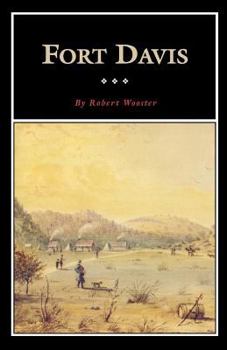Fort Davis: Outpost on the Texas Frontier
(Part of the Fred Rider Cotten Popular History Series Series)
Select Format
Select Condition 
Book Overview
This engaging, illustrated history of Fort Davis, one of the U.S. Army's most important western posts, relates the exciting history of Trans-Pecos Texas--the far western reaches off the state. Wooster traces the history of this Davis Mountains region from the days when Indians and later Spaniards and Mexicans inhabited the area, through its days as the site of Texan and American interests. The establishment and construction of Fort Davis in the mid-1850s tells the story of one of the army's largest western posts. We learn about the famous army camels which Secretary of War Jefferson Davis brought to the area, with Fort Davis serving as a base of operations, and about the difficult conditions imposed on the army by weather, climate, and Indians, Evacuated by the U.S. Army at the beginning of the Civil War, Fort Davis later was occupied by Texas state troops, then briefly reoccupied by the Federals. After the war, the War Department began shifting regular army units back to the western frontiers. Among these units were each of the famous black regiments, many of them composed of former slaves who proved to be excellent soldiers. The details of daily life--food, clothing, social activities, weapons, medical care--are thoroughly discussed, as are the often ineffective campaigns against Indians. Robert Wooster skillfully uses the forty-year history of Fort Davis to provide a clear window into the frontier military experience and into nineteenth-century American society. Because of its black soldiers, and its large Mexican-American civilian community, Fort Davis is a prime resource for studying and understanding the stratified racial relations which accompanied the army's and the nation's westward expansion.
Format:Paperback
Language:English
ISBN:0876111398
ISBN13:9780876111390
Release Date:June 1994
Publisher:Texas State Historical Assn
Length:58 Pages
Weight:0.28 lbs.
Dimensions:0.2" x 5.5" x 8.5"
Customer Reviews
1 rating
Good, short overview of Fort Davis, but without the bigger picture
Published by Thriftbooks.com User , 15 years ago
If you're visiting Fort Davis National Historic Site in West Texas, and if you'd like to know more than what the Park Service tells you at the site, this pamphlet is a good place to start. It's only about 50 pages, and an easy read. (Wooster has also written a longer book if you'd like more depth.) The pamphlet follows the topics you'd expect - - the problem of the frontier, US exploration in the region and establishment of the fort, a history of the military engagements, daily life in the fort, and the Buffalo Soldiers (African-American soldiers who made up most of the enlisted men at the fort). The book falls short in failing to look at the bigger picture. Why did the US expand westward in general, and into Texas in particular? Why were its conflicts with the Indians so different from the Mexican experience in the same region? Why did the Apaches and Comanches respond to the threat with raiding, as opposed to the other forms of resistance they might have tried? That might be asking too much for a pamphlet. But another five or ten pages setting the stage would have served Wooster well. Objections aside, it's a good background for your visit.






